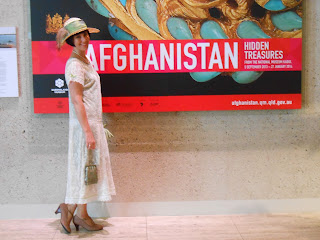I then faced the dilemma of the pattern. The skirt section didn’t phase me at all. I knew I would be drafting up a full 8 gore skirt. In my research, I was able to spot seams in the skirt. I drafted it as full as I could for the fabric. I wanted the skirt to float. I also cut out a petticoat of some stash cotton which would help hold the skirts out from my legs, giving it a nicer drape and providing a level of modesty if the wrap section opened up. This was especially an issue as I didn’t have enough fabric for an extra overlap layer of the outer skirts.
The bodice on the other hand took 4 drafts and mock-ups to get right. I started with halter vest pattern. I took out the length below the waist and drafted down the front to overlap. I then had to draft out the seams. This is what took the longest. Removing the seams yet keeping the shape intact. The one seam that proved the most difficult was at the bust. The bodice needed to support my bust enough that everything would stay in place. I ended up pivoting out the seam as much as I could. In the end, the piece came out really well and provided all the support I needed.
I constructed the bodice in 5 layers. Three interlining layers (the green) with boning. I used cable ties for my boning and in some of the channels doubled them up for extra strength. Then I added the outer layer and the lining layer. In hindsight, I should have used my outer fabric as my lining as well so that I didn’t get any roll, but I wanted cotton against my skin where possible.The skirt is sewn to the bottom of the outer layers and encased with the lining whip stitched in place. I finished off the bodice closure with a number of hooks and eyes. There is quite a bit of tension on them, but that is what holds the dress in place as well as providing bust support.
Then came the sleeves. I had assistance from my mum with drafting the pattern for these. I knew how I wanted to construct them, but we needed to drape them on my body to see how they fit. We draped paper over my arm and drafted the shape by hand. We redrafted the shape a couple of times to get it sitting right. I then cut out my sleeves from 2 layers of cotton velveteen and 1 layer of buckram. I millinery techniques to make the sleeve.
The first step was to stiffen the outer edge of the sleeve. I did so by sewing millinery wire with an overcast stitch along the edge. I then wrapped the first layer of velveteen around the sleeve and stitched it in place with a stab stitch (small back stitch). Next, I pinned the second layer of velveteen to the sleeve and used a whip stitch to sew along the edges to the first layer of velveteen.
The final step was to work out placement of the hooks and eyes on the sleeve. I added the hooks to the sleeve and had my mum put pins in where the eye would need to be sewn. I made thread eyes out of a matching blue thread so that they would be nearly invisible when worn.To finish it off, I added some ribbons in place to attach my belt. The belt itself is made from sculpy and wire that has been painted with bronze spray paint. I was lucky enough to purchase the clay rose from a costume jewellery store, and only had to make the branch. I rolled sculpy around a thin piece of wire and shaped it into the curve design. I added the thorns by making small pinches of clay and pushing them on, blending the edges. I then baked my clay. Once cool, I spray painted the lot with the bronze spray paint (I use auto paint). It was fully covered in a couple of light coats. I finished it off with a matte fixative so that the paint would not rub off on my costume.
To complete the costume, I found sandals in the same shade of blue as my costume, and I added a long brown wavy wig. All in all, a success. I am hugely proud of this costume, though was incredibly conscious of my boobs the entire day – checking to make sure I didn’t flash anyone unnecessary. Turns out, I need not have worried – it all stayed in place correctly. Though when I met Lena Hadley, she referred to me as “Mel with the boobs”. But then, that’s Margaery and her costumes for you.













































































